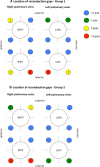Bonus-freeze: benefit or risk? Two-year outcome and procedural comparison of a "bonus-freeze" and "no bonus-freeze" protocol using the second-generation cryoballoon for pulmonary vein isolation
- PMID: 27085722
- PMCID: PMC4989001
- DOI: 10.1007/s00392-016-0987-8
Bonus-freeze: benefit or risk? Two-year outcome and procedural comparison of a "bonus-freeze" and "no bonus-freeze" protocol using the second-generation cryoballoon for pulmonary vein isolation
Abstract
Background: Second-generation cryoballoon based pulmonary vein isolation has demonstrated encouraging acute and mid-term clinical outcome. Customarily, a bonus-freeze is applied after successful pulmonary vein isolation.
Objective: To compare the long-term clinical outcome and safety profile of a bonus-freeze and a no bonus-freeze protocol.
Methods: A total of 120 consecutive patients with paroxysmal [95/120 (79 %)] or persistent atrial fibrillation [25/120 (21 %)] underwent CB2-based PVI. Freeze-cycle duration was 240 s. In the first 60 patients a bonus-freeze was applied after successful PVI (group 1), while in the following 60 patients the bonus-freeze was omitted (group 2).
Results: Procedure and fluoroscopy times were significantly shorter in group 2 [113.8 ± 32 vs 138.2 ± 29 min (p = 0.03) and 19.2 ± 6 vs 24.3 ± 8 min (p = 0.02)]. No differences in procedural complications were found. During a mean follow-up of 849 ± 74 (group 1) and 848 ± 101 days (group 2, p = 0.13) 69 % of patients (group 1) and 67 % of patients (group 2) remained in stable sinus rhythm without any differences between the groups (p = 0.69).
Conclusions: Freedom from atrial fibrillation after second-generation cryoballoon based pulmonary vein isolation and a follow-up of >2 years is comparable when applying a bonus- and a no bonus-freeze protocol, while procedure and fluoroscopy times are significantly shorter when omitting the bonus-freeze. No differences in periprocedural complications were identified.
Keywords: Atrial fibrillation; Cryoballoon; Long-term follow-up; Pulmonary vein isolation.
Figures



References
-
- Metzner A, Reissmann B, Rausch P, Mathew S, Wohlmuth P, Tilz R, Rillig A, Lemes C, Deiss S, Heeger C, Kamioka M, Lin T, Ouyang F, Kuck KH, Wissner E. One-year clinical outcome after pulmonary vein isolation using the second-generation 28-mm cryoballoon. Circ Arrhythm Electrophysiol. 2014;7:288–292. doi: 10.1161/CIRCEP.114.001473. - DOI - PubMed
-
- Wissner E, Heeger CH, Grahn H, Reissmann B, Wohlmuth P, Lemes C, Rausch P, Mathew S, Rillig A, Deiss S, Maurer T, Lin T, Tilz RR, Ouyang F, Kuck KH, Metzner A. One-year clinical success of a ‘no-bonus’ freeze protocol using the second-generation 28 mm cryoballoon for pulmonary vein isolation. Europace. 2015;17:1236–1240. doi: 10.1093/europace/euv024. - DOI - PubMed
-
- Metzner A, Heeger CH, Wohlmuth P, Reissmann B, Rillig A, Tilz RR, Mathew S, Lemes C, Deiss S, Maurer T, Saguner A, Ouyang F, Kuck KH, Wissner E. Two-year outcome after pulmonary vein isolation using the second-generation 28-mm cryoballoon: lessons from the bonus freeze protocol. Clin Res Cardiol. 2016;105:72–78. doi: 10.1007/s00392-015-0890-8. - DOI - PubMed
-
- Ciconte G, de Asmundis C, Sieira J, Conte G, Di Giovanni G, Mugnai G, Saitoh Y, Baltogiannis G, Irfan G, Coutino-Moreno HE, Hunuk B, Velagic V, Brugada P, Chierchia GB. Single 3-min freeze for second-generation cryoballoon ablation: one-year follow-up after pulmonary vein isolation. Heart Rhythm. 2015;12:673–680. doi: 10.1016/j.hrthm.2014.12.026. - DOI - PubMed
-
- Furnkranz A, Bordignon S, Dugo D, Perotta L, Gunawardene M, Schulte-Hahn B, Nowak B, Schmidt B, Chun JK. Improved 1-year clinical success rate of pulmonary vein isolation with the second-generation cryoballoon in patients with paroxysmal atrial fibrillation. J Cardiovasc Electrophysiol. 2014;225:840–844. doi: 10.1111/jce.12417. - DOI - PubMed
Publication types
MeSH terms
LinkOut - more resources
Full Text Sources
Other Literature Sources
Medical

